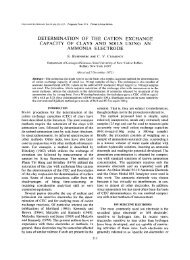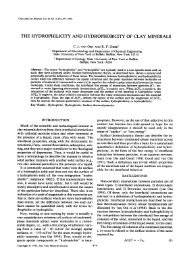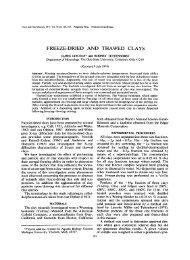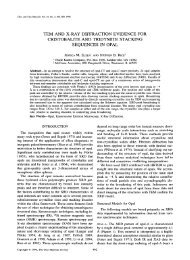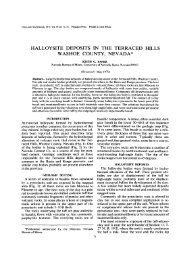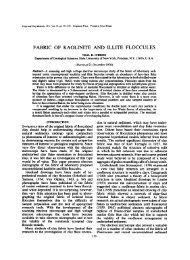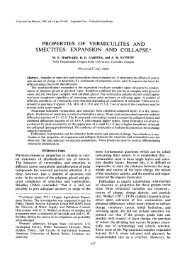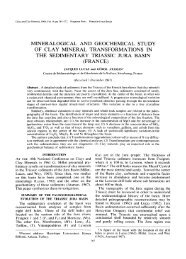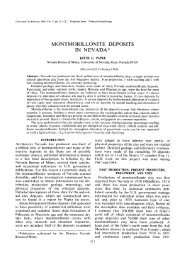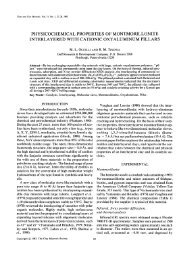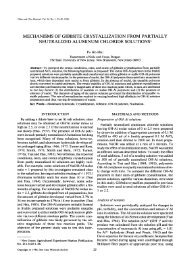formation of halloysite from feldspar: low temperature, artificial ...
formation of halloysite from feldspar: low temperature, artificial ...
formation of halloysite from feldspar: low temperature, artificial ...
Create successful ePaper yourself
Turn your PDF publications into a flip-book with our unique Google optimized e-Paper software.
FORMATION OF HALLOYS1TE FROM FELDSPAR 19<br />
product formed on the plagioclase <strong>feldspar</strong><br />
surface is boehmite.<br />
The boehmite crystals form within the flameshaped<br />
sheets (Fig. 10), <strong>from</strong> which they are<br />
ultimately released. Considering the somewhat<br />
ragged outline <strong>of</strong> flakes within the sheet in Fig. 10,<br />
it might seem that they undergo some further<br />
growth after their release. No naturally weathered<br />
plagioclase (An70) <strong>feldspar</strong>s have yet been studied<br />
for comparison purposes.<br />
DISCUSSION<br />
Comparison in this study <strong>of</strong> <strong>artificial</strong>ly and<br />
naturally produced surface weathering products<br />
on <strong>feldspar</strong>s suggests that the products, whether<br />
formed in an <strong>artificial</strong> or natural weathering environment,<br />
evolve in a similar way. Further, <strong>halloysite</strong><br />
and boehmite seem to be the new mineral phases<br />
produced under these <strong>artificial</strong> weathering conditions<br />
and that their <strong>formation</strong> is in part related<br />
to the chemical composition <strong>of</strong> the parent <strong>feldspar</strong>s.<br />
What the detailed nature <strong>of</strong> the transition<br />
phases that exist between unaltered <strong>feldspar</strong> and<br />
either <strong>halloysite</strong> or boehmite are, is not known<br />
at present. Speculation based on their morphological<br />
aspects and <strong>from</strong> the literature suggest that<br />
these intermediate forms might be classed as allophane.<br />
The composition <strong>of</strong> the flame-shaped sheets<br />
shown in Figs. 6A, 6B, 8, and l0 is not known.<br />
Published electron micrographs <strong>of</strong> allophane<br />
(Beutelspacher and van der Marel, 1968), (Grim,<br />
1968) are dissimilar to the flame-shaped sheets<br />
and other weathering products formed on either<br />
<strong>feldspar</strong> type. On the other hand, Yoshinaga<br />
et a/.(1968) have shown electron micrographs <strong>of</strong><br />
soil allophane exhibiting a certain degree <strong>of</strong> structural<br />
order that corresponds in form to the tapered<br />
projections formed on both <strong>artificial</strong>ly weathered<br />
<strong>feldspar</strong>s. Perhaps, as suggested by Sudo and<br />
Takahashi (1956), Jackson (1959), and Keller<br />
(1964), during rock weathering minerals such as<br />
<strong>feldspar</strong> alter first to allophane and then to <strong>halloysite</strong>.4H20.<br />
The results <strong>of</strong> leaching experiments<br />
similar to this one (Pedro, and Berrier, 1966;<br />
Pickering, 1962) suggest that the flame-shaped<br />
sheets formed on the K-<strong>feldspar</strong> would have a<br />
chemical composition approximating allophane or<br />
<strong>halloysite</strong>.<br />
Low <strong>temperature</strong> studies on the alteration <strong>of</strong> K-<br />
<strong>feldspar</strong> in solutions <strong>of</strong> varied pH (Wollast, 1967)<br />
indicate that kaolinite will form only if the leaching<br />
solutions contain silica in excess <strong>of</strong> about 5 ppm.<br />
It is assumed that this concentration <strong>of</strong> silica would<br />
be necessary also for the <strong>formation</strong> <strong>of</strong> <strong>halloysite</strong>.<br />
When the silica content falls be<strong>low</strong> this level (about<br />
5 ppm), <strong>formation</strong> <strong>of</strong> various hydrous aluminum<br />
oxides should take place instead. Pickering (1962)<br />
speculated that "In well-drained soils in areas <strong>of</strong><br />
high rainfall the groundwater is probably undersaturated<br />
with many <strong>of</strong> the chemical products<br />
<strong>of</strong> weathering." This <strong>artificial</strong> weathering study<br />
simulated conditions <strong>of</strong> good drainage in combination<br />
with high rainfall. It is likely that the solutions<br />
leaching the plagioclase <strong>feldspar</strong> may be undersaturated<br />
with respect to silica, thus inhibiting<br />
<strong>formation</strong> <strong>of</strong> <strong>halloysite</strong> but instead favoring<br />
<strong>formation</strong> <strong>of</strong> boehmite. The SiOJAl203 ratio for<br />
the original plagioclase (ANT0) <strong>feldspar</strong> was l-5/1,<br />
whereas the ratio in the K-<strong>feldspar</strong> was 3"3/1.<br />
The variation in silica content <strong>of</strong> the two <strong>feldspar</strong>s<br />
coupled with their different end products <strong>of</strong> weathering<br />
also suggests that the K-<strong>feldspar</strong> silica content<br />
is sufficiently high to maintain a silica concentration<br />
in the leaching solution above Wollast's<br />
(1967) figure <strong>of</strong> about 5 ppm, and thus al<strong>low</strong><br />
hailoysite to form as the stable alteration product<br />
whereas at the same time <strong>halloysite</strong> would not<br />
form <strong>from</strong> the plagioclase (ANT0) <strong>feldspar</strong>.<br />
Pickering's (1962) experiments further indicated<br />
that within the normal natural weathering <strong>temperature</strong><br />
range <strong>of</strong> 0-35~ dissolution reactions in<br />
silicate rocks are essentially the same, indicating<br />
to him that chemical weathering processes are no<br />
different in the tropics than in cooler climates.<br />
The warmer <strong>temperature</strong>s <strong>of</strong> the tropics would<br />
have the effect merely <strong>of</strong> speeding up the dissolution<br />
process. Replicas <strong>of</strong> surface alteration<br />
products formed <strong>from</strong> <strong>feldspar</strong>s weathered under<br />
varied climatic conditions have as yet not been<br />
examined with the electron microscope. Such<br />
in<strong>formation</strong> is needed for correlation with the<br />
results <strong>of</strong> Picketing (1962) and Wollast (1967).<br />
Occurrences <strong>of</strong> <strong>halloysite</strong> in weathered materials<br />
within the geologic column seem to be less common<br />
with increasing age. The common occurence <strong>of</strong><br />
<strong>halloysite</strong> in modern weathering products suggests<br />
that the element <strong>of</strong> time is related to the presence<br />
<strong>of</strong> <strong>halloysite</strong> and that <strong>halloysite</strong> may change s<strong>low</strong>ly<br />
with time to kaolinite. However, well preserved<br />
tubular <strong>halloysite</strong> is found with platy kaolinite in<br />
a weathered residuum <strong>of</strong> Jurassic or Cretaceous<br />
age developed <strong>from</strong> Precambrian granite-gneisses<br />
in Minnesota. In this case, at least, <strong>halloysite</strong> has<br />
been stable for a considerable period <strong>of</strong> geologic<br />
time. Moreover, kaolinite has <strong>of</strong>ten been reported<br />
in modern weathering products as well, further<br />
complicating understanding <strong>of</strong> the geologic relationship<br />
between the two minerals.<br />
It seems however that certain <strong>of</strong> these problem<br />
areas can be eliminated with similar <strong>artificial</strong><br />
weathering studies and with further examination<br />
<strong>of</strong> the weathering products with the electron<br />
microscope. The apparent latitude that exists in



